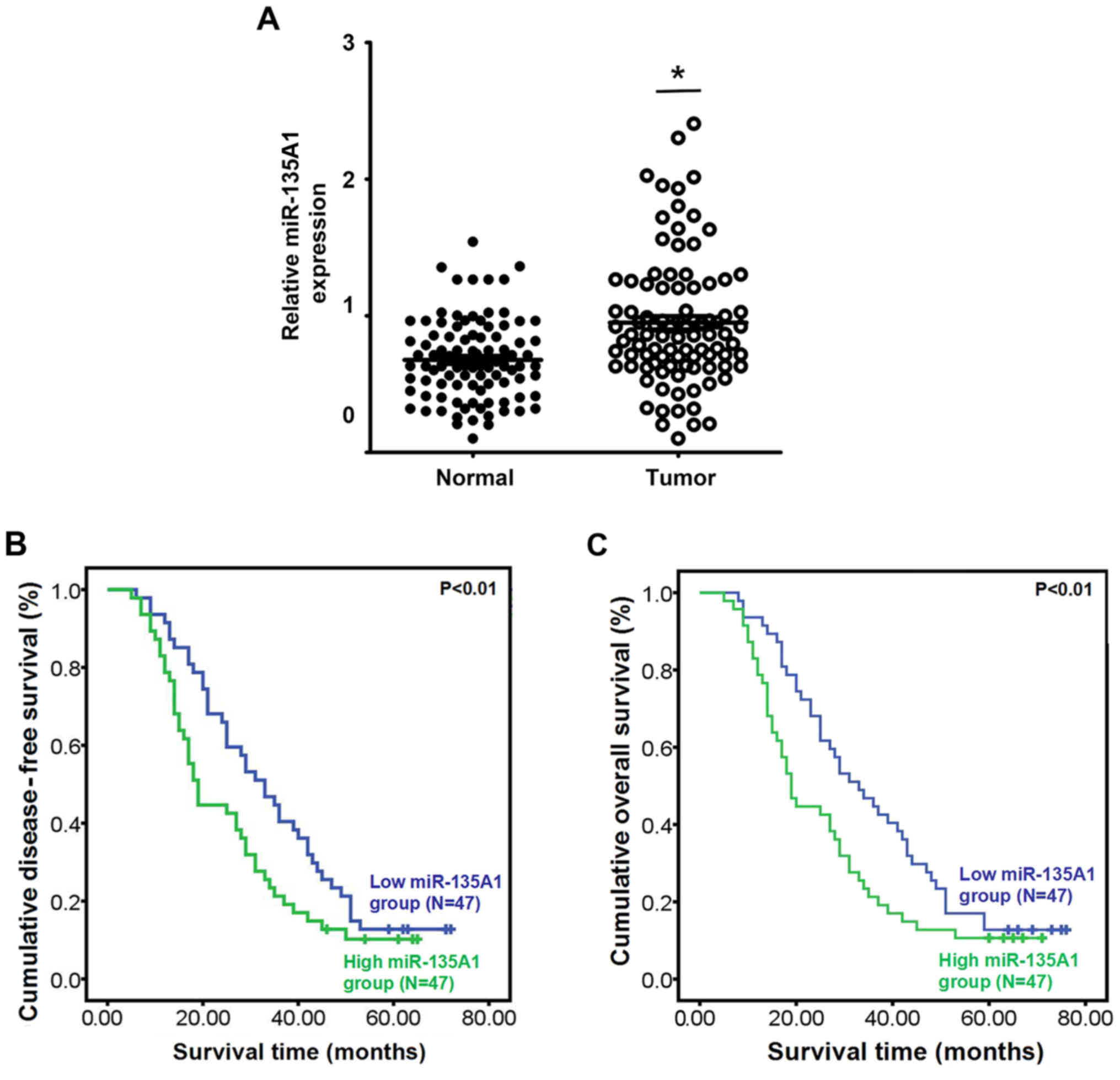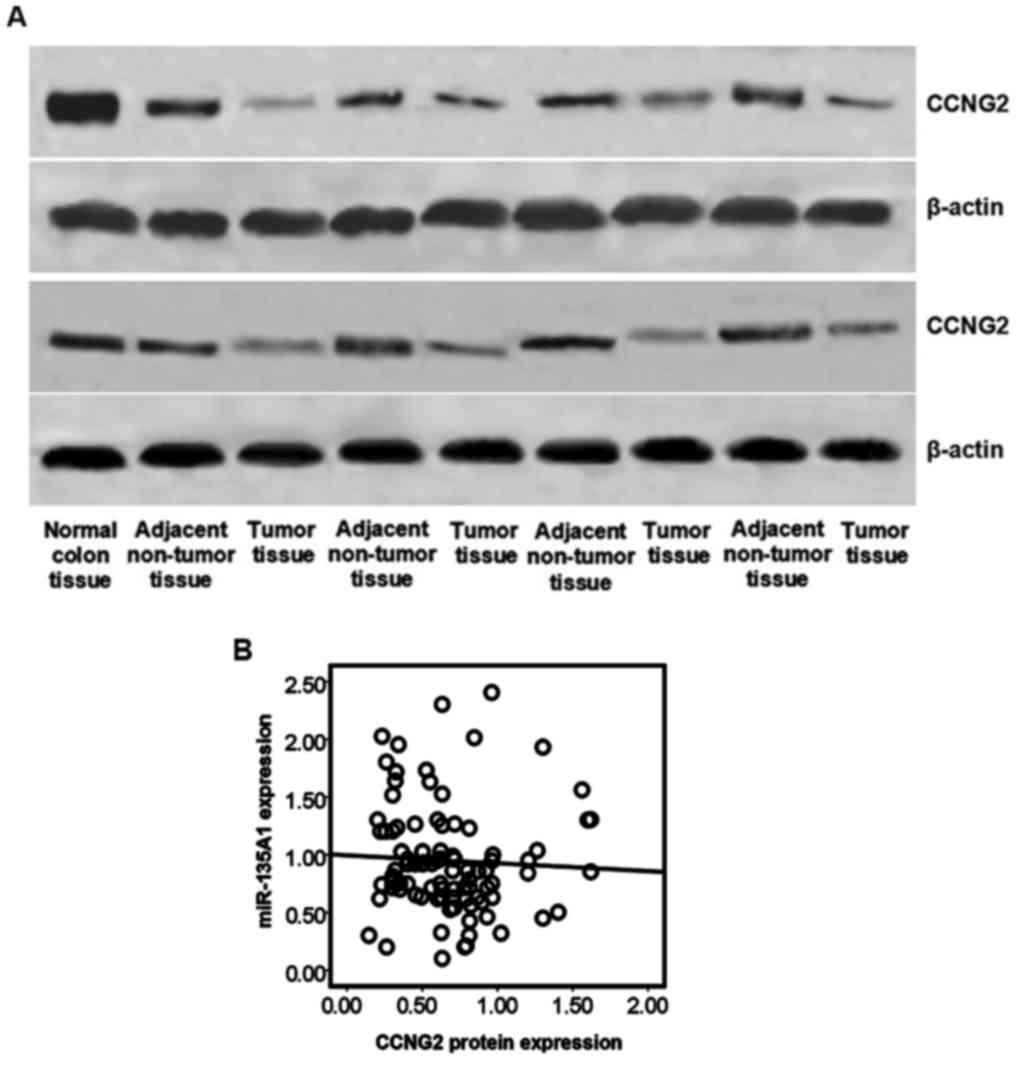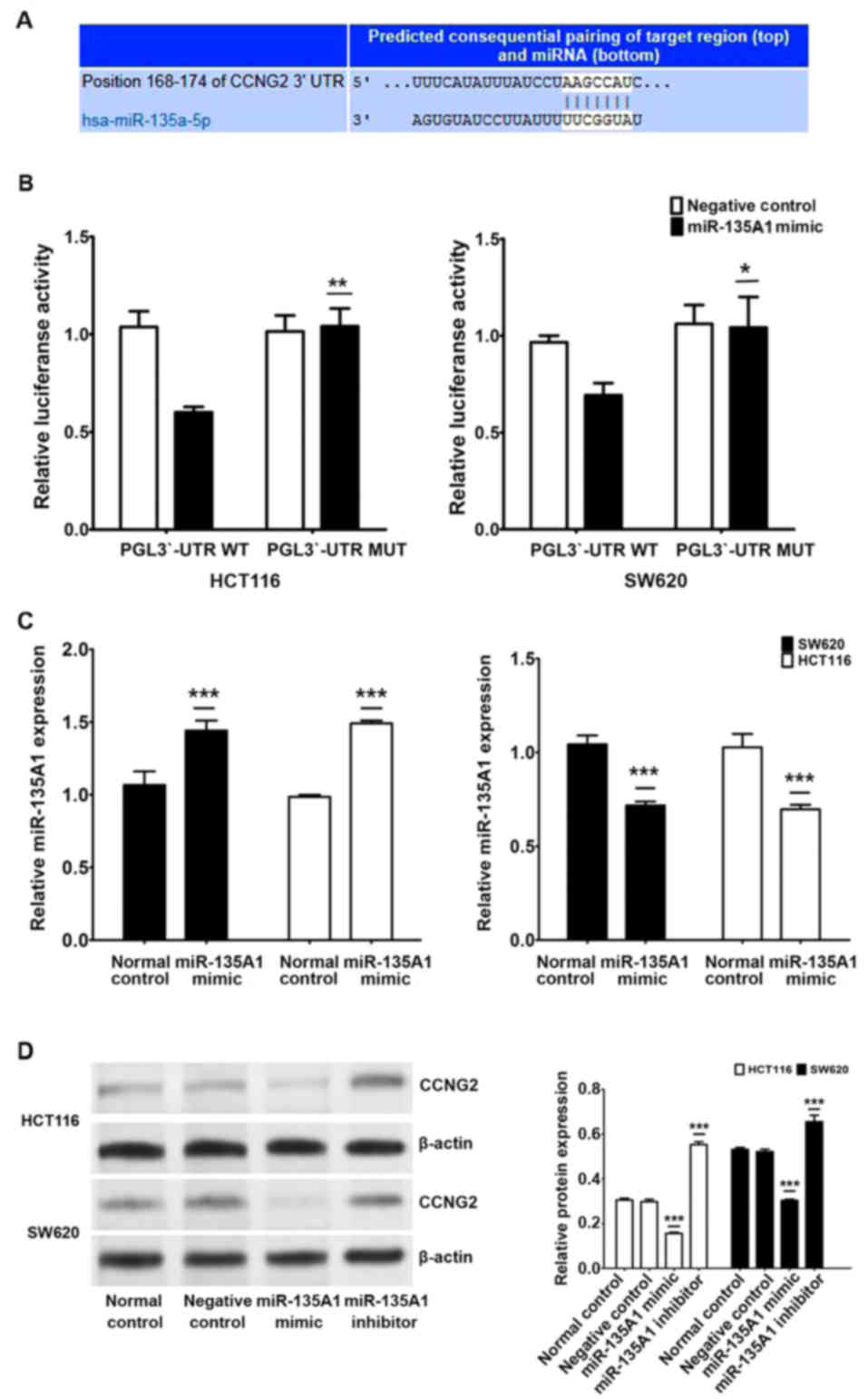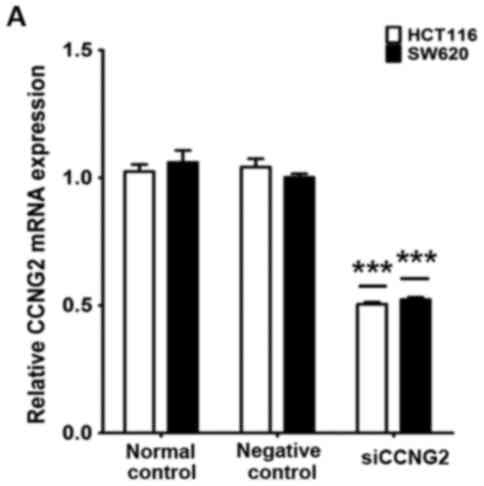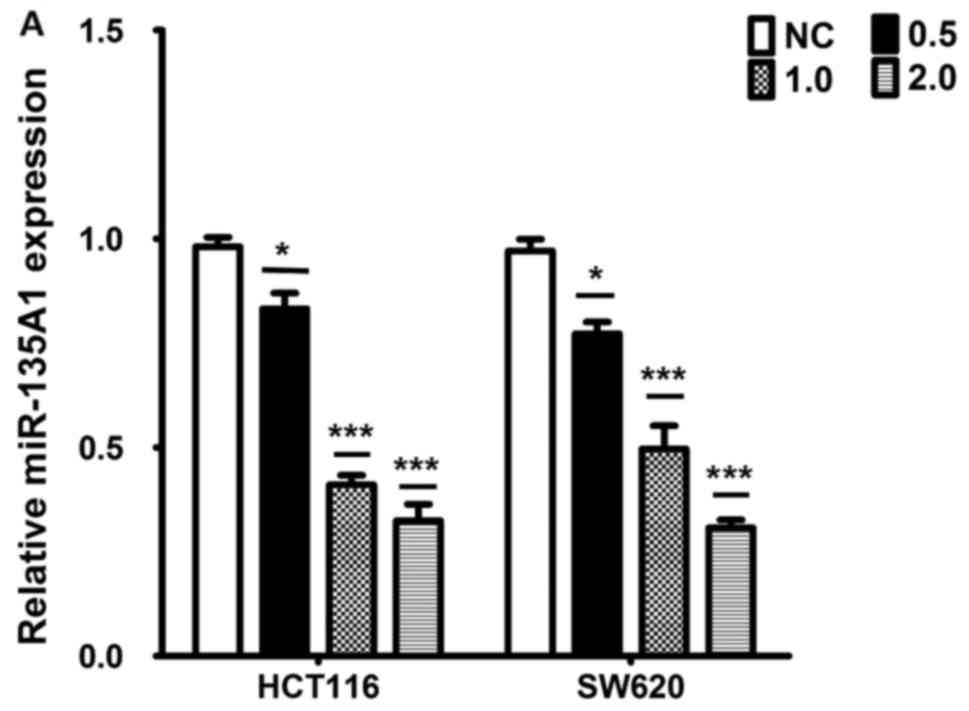|
1
|
Siegel RL, Miller KD, Fedewa SA, Ahnen DJ,
Meester RGS, Barzi A and Jemal A: Colorectal cancer statistics.
2017 CA Cancer J Clin. 67:177–193. 2017. View Article : Google Scholar : PubMed/NCBI
|
|
2
|
Punt CJ, Koopman M and Vermeulen L: From
tumour heterogeneity to advances in precision treatment of
colorectal cancer. Nat Rev Clin Oncol. 14:235–246. 2017. View Article : Google Scholar : PubMed/NCBI
|
|
3
|
Chen W, Zheng R, Baade PD, Zhang S, Zeng
H, Bray F, Jemal A, Yu XQ and He J: Cancer statistics in China,
2015. CA Cancer J Clin. 66:115–132. 2016. View Article : Google Scholar : PubMed/NCBI
|
|
4
|
Jiang H, Tang E, Xu D, Chen Y, Zhang Y,
Tang M, Xiao Y, Zhang Z, Deng X, Li H, et al: Development and
validation of nomograms for predicting survival in patients with
non-metastatic colorectal cancer. Oncotarget. 8:29857–29864.
2017.PubMed/NCBI
|
|
5
|
Li G, Thomas AM, Hart SN, Zhong X, Wu D
and Guo GL: Farnesoid X receptor activation mediates head-to-tail
chromatin looping in the Nr0b2 gene encoding small heterodimer
partner. Mol Endocrinol. 24:1404–1412. 2010. View Article : Google Scholar : PubMed/NCBI
|
|
6
|
Ananthanarayanan M, Balasubramanian N,
Makishima M, Mangelsdorf DJ and Suchy FJ: Human bile salt export
pump promoter is transactivated by the Farnesoid X receptor/bile
acid receptor. J Biol Chem. 276:28857–28865. 2001. View Article : Google Scholar : PubMed/NCBI
|
|
7
|
Debruyne PR, Bruyneel EA, Karaguni IM, Li
X, Flatau G, Müller O, Zimber A, Gespach C and Mareel MM: Bile
acids stimulate invasion and haptotaxis in human colorectal cancer
cells through activation of multiple oncogenic signaling pathways.
Oncogene. 21:6740–6750. 2002. View Article : Google Scholar : PubMed/NCBI
|
|
8
|
Torres J, Bao X, Iuga AC, Chen A, Harpaz
N, Ullman T, Cohen BL, de Chambrun Pineton G, Asciutti S, Odin JA,
et al: Farnesoid X receptor expression is decreased in colonic
mucosa of patients with primary sclerosing cholangitis and
colitis-associated neoplasia. Inflamm Bowel Dis. 19:275–282. 2013.
View Article : Google Scholar : PubMed/NCBI
|
|
9
|
Yang F, Gong J, Wang G, Chen P, Yang L and
Wang Z: Waltonitone inhibits proliferation of hepatoma cells and
tumorigenesis via FXR-miR-22-CCNA2 signaling pathway. Oncotarget.
7:75165–75175. 2016. View Article : Google Scholar : PubMed/NCBI
|
|
10
|
He J, Zhao K, Zheng L, Xu Z, Gong W, Chen
S, Shen X, Huang G, Gao M, Zeng Y, et al: Upregulation of
microRNA-122 by Farnesoid X receptor suppresses the growth of
hepatocellular carcinoma cells. Mol Cancer. 14:1632015. View Article : Google Scholar : PubMed/NCBI
|
|
11
|
Qiao P, Li G, Bi W, Yang L, Yao L and Wu
D: microRNA-34a inhibits epithelial mesenchymal transition in human
cholangiocarcinoma by targeting Smad4 through transforming growth
factor-beta/Smad pathway. BMC Cancer. 15:4692015. View Article : Google Scholar : PubMed/NCBI
|
|
12
|
Bandres E, Agirre X, Bitarte N, Ramirez N,
Zarate R, Roman-Gomez J, Prosper F and Garcia-Foncillas J:
Epigenetic regulation of microRNA expression in colorectal cancer.
Int J Cancer. 125:2737–2743. 2009. View Article : Google Scholar : PubMed/NCBI
|
|
13
|
Zhou H, Guo W, Zhao Y, Wang Y, Zha R, Ding
J, Liang L, Yang G, Chen Z, Ma B, et al: MicroRNA-135a acts as a
putative tumor suppressor by directly targeting very low density
lipoprotein receptor in human gallbladder cancer. Cancer Sci.
105:956–965. 2014. View Article : Google Scholar : PubMed/NCBI
|
|
14
|
Leung O: Identification and
characterization of microRNA-135A in cervical carcinogenesis. J
Medicinal Food. 16:701–710. 2013.
|
|
15
|
Tribollet V, Barenton B, Kroiss A, Vincent
S, Zhang L, Forcet C, Cerutti C, Périan S, Allioli N, Samarut J, et
al: miR-135a inhibits the invasion of cancer cells via suppression
of ERRα. PLos One. 11:e01564452016. View Article : Google Scholar : PubMed/NCBI
|
|
16
|
Nagel R, le Sage C, Diosdado B, van der
Waal M, Vrielink Oude JA, Bolijn A, Meijer GA and Agami R:
Regulation of the adenomatous polyposis coli gene by the miR-135
family in colorectal cancer. Cancer Res. 68:5795–5802. 2008.
View Article : Google Scholar : PubMed/NCBI
|
|
17
|
Sobin L, Gospodarowicz M and Wittekind C:
TNM Classification of Malignant Tumors. UICC International Union
Against Cancer (7th edition). 2009.
|
|
18
|
Sun C, Wang FJ, Zhang HG, Xu XZ, Jia RC,
Yao L and Qiao PF: miR-34a mediates oxaliplatin resistance of
colorectal cancer cells by inhibiting macroautophagyviatransforming
growth factor-β/Smad4 pathway: World J Gastroenterol. 23:1816–1827.
2017.
|
|
19
|
Livak KJ and Schmittgen TD: Analysis of
relative gene expression data using real-time quantitative PCR and
the 2−ΔΔCT method. Methods. 25:402–408. 2001.
View Article : Google Scholar : PubMed/NCBI
|
|
20
|
Wang Q, Zhang H, Shen X and Ju S: Serum
microRNA-135a-5p as an auxiliary diagnostic biomarker for
colorectal cancer. Ann Clin Biochem. 54:76–85. 2017. View Article : Google Scholar : PubMed/NCBI
|
|
21
|
Wang S, Zeng Y, Zhou JM, Nie SL, Peng Q,
Gong J and Huo JR: MicroRNA-1246 promotes growth and metastasis of
colorectal cancer cells involving CCNG2 reduction. Mol Med Rep.
13:273–280. 2016. View Article : Google Scholar : PubMed/NCBI
|
|
22
|
de Aguiar Vallim TQ, Tarling EJ, Kim T,
Civelek M, Baldán Á, Esau C and Edwards PA: MicroRNA-144 regulates
hepatic ABCA1 and plasma HDL following activation of the nuclear
receptor fxr. Circ Res. 112:1602–1612. 2013. View Article : Google Scholar : PubMed/NCBI
|
|
23
|
Sun GG, Zhang J and Hu WN: CCNG2
expression is downregulated in colorectal carcinoma and its
clinical significance. Tumour Biol. 35:3339–3346. 2014. View Article : Google Scholar : PubMed/NCBI
|
|
24
|
Hasegawa S, Eguchi H, Nagano H, Konno M,
Tomimaru Y, Wada H, Hama N, Kawamoto K, Kobayashi S, Nishida N, et
al: MicroRNA-1246 expression associated with CCNG2-mediated
chemoresistance and stemness in pancreatic cancer. Br J Cancer.
111:1572–1580. 2014. View Article : Google Scholar : PubMed/NCBI
|
|
25
|
Monte MJ, Serrano MA, Herraez E, Vaquero
J, Gonzalez-Sanchez E, Romero MR, Rosales RR, Blazquez AG, Perez
MJ, Macias RI, et al: Chemoresistance can be induced by bile
acid-independent activation of FXR in liver and intestinal cancer
cells. Hepatology. 54:713–714. 2011.
|
|
26
|
Bailey AM, Zhan L, Maru D, Shureiqi I,
Pickering CR, Kiriakova G, Izzo J, He N, Wei C, Baladandayuthapani
V, et al: FXR silencing in human colon cancer by DNA methylation.
Am J Physiol Gastrointest Liver Physiol. 306:G48–G58. 2014.
View Article : Google Scholar : PubMed/NCBI
|
|
27
|
Gadaleta RM, Cariello M, Sabbà C and
Moschetta A: Tissue-specific actions of FXR in metabolism and
cancer. Biochimica Biophysica Acta. 1851:30–39. 2015. View Article : Google Scholar
|
|
28
|
Fiorucci S, Rizzo G, Antonelli E, Renga B,
Mencarelli A, Riccardi L, Morelli A, Pruzanski M and Pellicciari R:
Cross-talk between farnesoid-X-receptor (FXR) and peroxisome
proliferator-activated receptor gamma contributes to the
antifibrotic activity of FXR ligands in rodent models of liver
cirrhosis. J Pharmacol Exp Ther. 315:58–68. 2005. View Article : Google Scholar : PubMed/NCBI
|















